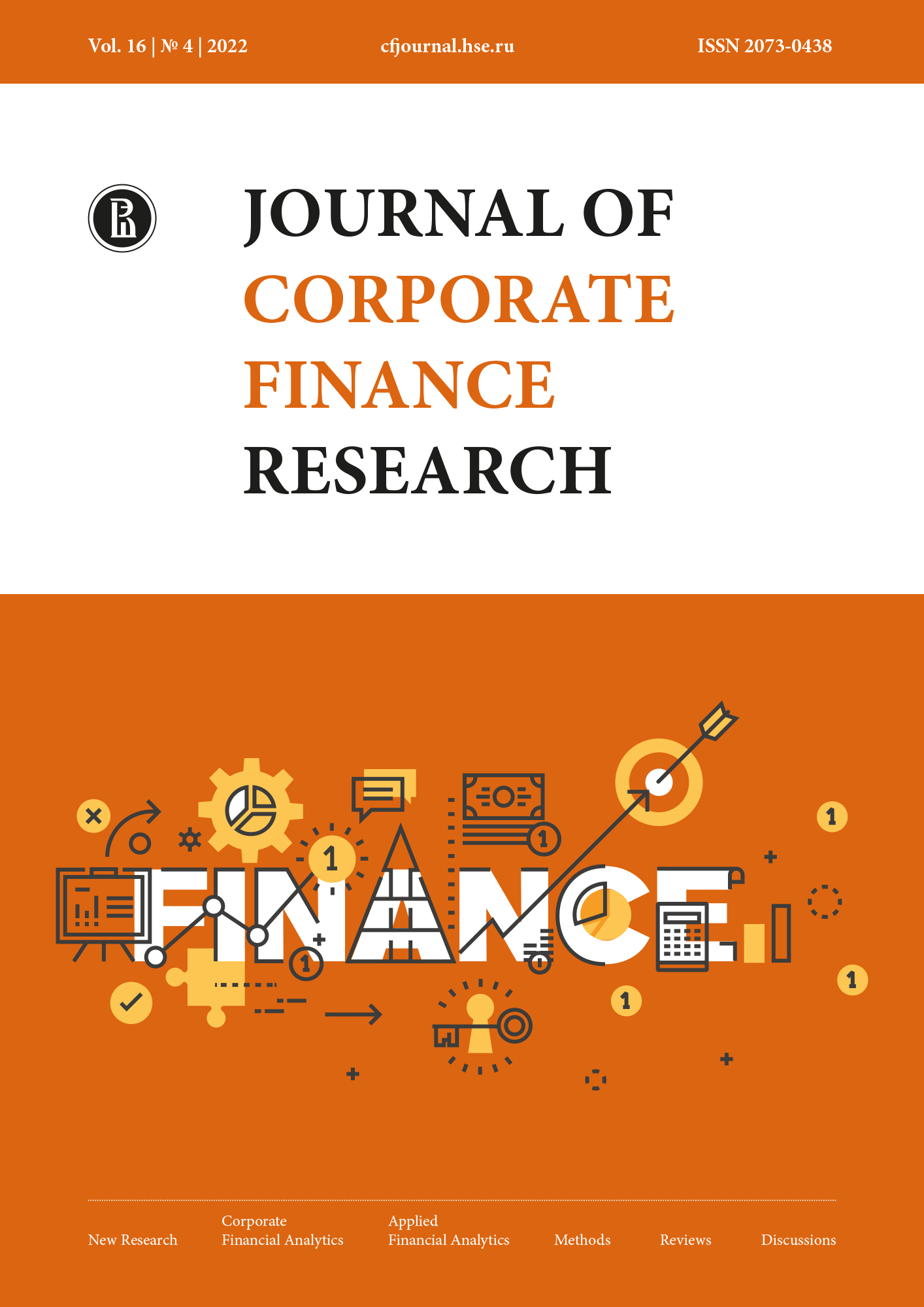Влияние самоуверенности генерального директора на эффективность сделок M&A в США: текстовый анализ
Аннотация
Несмотря на высокую активность на рынке корпоративного контроля, более 60% сделок M&A оказываются неудачными и способствуют разрушению стоимости компании-покупателя. Однако, мы все еще мало знаем о влиянии сделок M&A на благосостояние акционеров в разных странах и об источниках создания стоимости в сделках. Ученые и практики продолжают поиск факторов, влияющих на результативность сделок M&A, но пока так и не приходят к единому мнению о наборе детерминант успешности сделок, что указывает на необходимость дальнейших исследований в этом направлении. В данной статье изучается влияние самоуверенности CEO на эффективность сделок M&A в США. В отличие от предыдущих исследований мы, во-первых, используем стенограммы звонков о доходах (earnings call) в рамках контент-анализа в качестве базы для измерения самоуверенности CEO; во-вторых, на основе кластерного анализа даем объяснение факторов, формирующих схожее поведение и речь СЕО во время звонков о доходах (earnings call) и, в-третьих, оцениваем влияние самоуверенности CEO на эффективность высокотехнологичных сделок M&A. Исследование основано на выборке из 492 сделок M&A, осуществленных в посткризисный период 2009-2019 годов. Используя метод событий для оценки эффективности сделок M&A и регрессионный анализ, мы доказываем, что самоуверенность CEO негативно влияет на успех слияний и поглощений. Однако, в случае приобретения высокотехнологических компаний, нам не удалось выявить значимого влияния самоуверенности CEO на эффективность сделок M&A. В результате кластерного анализа нами был выделен кластер из 165 компаний с общей структурой и сходством речей генеральных директоров, которые не объясняются принадлежностью компаний к схожим отраслям. Это говорит о том, что самоуверенные CEO имеют тенденцию к использованию и структурированию своих выступлений аналогичным образом.
Скачивания
Литература
Hirshleifer D., Low A., Teoh S.H. Are overconfident CEOs better innovators? The Journal of Finance. 2012;67(4):1457-1498. https://doi.org/10.1111/j.1540-6261.2012.01753.x DOI: https://doi.org/10.1111/j.1540-6261.2012.01753.x
Roll R. The hubris hypothesis of corporate takeovers. The Journal of Business. 1986;59(2):197-216. https://doi.org/10.1086/296325 DOI: https://doi.org/10.1086/296325
Malmendier U., Tate G. Who makes acquisitions? CEO overconfidence and the market’s reaction. Journal of Financial Economics. 2008;89(1):20-43. https://doi.org/10.1016/j.jfineco.2007.07.002 DOI: https://doi.org/10.1016/j.jfineco.2007.07.002
Brown R., Sarma N. CEO overconfidence, CEO dominance and corporate acquisitions. Journal of Economics and Business. 2007;59(5):358-379. https://doi.org/10.1016/j.jeconbus.2007.04.002 DOI: https://doi.org/10.1016/j.jeconbus.2007.04.002
Kolasinski A.C., Li X. Can strong boards and trading their own firm’s stock help CEOs make better decisions? Evidence from acquisitions by overconfident CEOs. Journal of Financial and Quantitative Analysis. 2013;48(4):1173-1206. https://doi.org/10.1017/S0022109013000392 DOI: https://doi.org/10.1017/S0022109013000392
Hwang Н., Kim H.-D., Kim T. The blind power: Power-led CEO overconfidence and M&A decision making. The North American Journal of Economics and Finance. 2020;52:101141. https://doi.org/10.1016/j.najef.2019.101141 DOI: https://doi.org/10.1016/j.najef.2019.101141
Ismail A., Mavis C.P. A new method for measuring CEO overconfidence: Evidence from acquisitions. International Review of Financial Analysis. 2022;79:101964. https://doi.org/10.1016/j.irfa.2021.101964 DOI: https://doi.org/10.1016/j.irfa.2021.101964
Rossi M., Yedidia Tarba S., Raviv A. Mergers and acquisitions in the hightech industry: A literature review. International Journal of Organizational Analysis. 2013;21(1):66-82. https://doi.org/10.1108/19348831311322542 DOI: https://doi.org/10.1108/19348831311322542
Langer E.J. The illusion of control. Journal of Personality and Social Psychology. 1975;32(2):311-328. https://doi.org/10.1037/0022-3514.32.2.311 DOI: https://doi.org/10.1037//0022-3514.32.2.311
Malmendier U., Tate G. CEO overconfidence and corporate investment. The Journal of Finance. 2005;60(6):2661-2700. https://doi.org/10.1111/j.1540-6261.2005.00813.x DOI: https://doi.org/10.1111/j.1540-6261.2005.00813.x
Garrard P., Rentoumi V., Lambert C., Owen D. Linguistic biomarkers of Hubris syndrome. Cortex. 2014;55:167-181. https://doi.org/10.1016/j.cortex.2013.08.014 DOI: https://doi.org/10.1016/j.cortex.2013.08.014
Merkl-Davies D.M., Brennan N.M. A conceptual framework of impression management: New insights from psychology, sociology and critical perspectives. Accounting and Business Research. 2011;41(5):415-437. https://doi.org/10.1080/00014788.2011.574222 DOI: https://doi.org/10.1080/00014788.2011.574222
Lee J.M., Hwang B.-H., Chen H. Are founder CEOs more overconfident than professional CEOs? Evidence from S&P 1500 companies. Strategic Management Journal. 2017;38(3):751-769. https://doi.org/10.1002/smj.2519 DOI: https://doi.org/10.1002/smj.2519
Craig R., Amernic J. Detecting linguistic traces of destructive narcissism at-a-distance in a CEO’s letter to shareholders. Journal of Business Ethics. 2011;101(4):563-575. https://doi.org/10.1007/s10551-011-0738-8 DOI: https://doi.org/10.1007/s10551-011-0738-8
Loughran T., Mcdonald B. When is a liability not a liability? Textual analysis, dictionaries, and 10-Ks. The Journal of Finance. 2011;66(1):35-65. https://doi.org/10.1111/j.1540-6261.2010.01625.x DOI: https://doi.org/10.1111/j.1540-6261.2010.01625.x
Loughran T., Mcdonald B. Textual analysis in accounting and finance: A survey. Journal of Accounting Research. 2016;54(4):1187-1230. https://doi.org/10.1111/1475-679X.12123 DOI: https://doi.org/10.1111/1475-679X.12123
Doukas J.A., Petmezas D. Acquisitions, overconfident managers and self-attribution bias. European Financial Management. 2007;13(3):531-577. https://doi.org/10.1111/j.1468-036X.2007.00371.x DOI: https://doi.org/10.1111/j.1468-036X.2007.00371.x
Skvortsova I., Vershinina A. Do cognitive biases impact M&A performance in emerging markets? Evidence from Russian firms. Basic Research Program Working Papers. Series: Financial Economics. WP BRP. 2021;(82). URL: https://wp.hse.ru/data/2021/05/26/1438204408/82FE2021.pdf
Masulis R.W., Wang C., Xie F. Corporate governance and acquirer returns. The Journal of Finance. 2007;62(4):1851–1889. https://doi.org/10.1111/j.1540-6261.2007.01259.x DOI: https://doi.org/10.1111/j.1540-6261.2007.01259.x
Galasso A., Simcoe T.S. CEO overconfidence and innovation. Management Science. 2011;57(8):1469-1484. https://doi.org/10.1287/mnsc.1110.1374 DOI: https://doi.org/10.1287/mnsc.1110.1374
Karnoukhova E., Stepanova A.N. Does smart & powerful CEO contribute to the performance of technology companies? Journal of Corporate Finance Research. 2019;13(4):39-58. https://doi.org/10.17323/j.jcfr.2073-0438.13.4.2019.39-58 DOI: https://doi.org/10.17323/j.jcfr.2073-0438.13.4.2019.39-58
Gubbi S.R., Aulakh P.S., Ray S., Sarkar M.B., Chittoor R. Do international acquisitions by emerging-economy firms create shareholder value? The case of Indian firms. Journal of International Business Studies. 2010;41(3):397-418. https://doi.org/10.1057/jibs.2009.47 DOI: https://doi.org/10.1057/jibs.2009.47
Weston J.F., Siu J.A, Johnson B.A. Takeovers, restructuring and corporate governance. Englewood Cliffs, NJ: Prentice-Hall; 2002. 689 p..
Kothari S.P., Warner J.B. Econometrics of event studies. In: Eckbo B.E., ed. Handbook of corporate finance: Empirical corporate finance. Vol. 1. Amsterdam: North-Holland; 2007:3-36. DOI: https://doi.org/10.1016/B978-0-444-53265-7.50015-9
Kile C.O., Phillips M.E. Using industry classification codes to sample high-technology firms: Analysis and recommendations. Journal of Accounting, Auditing & Finance. 2009;24(1):35-57. https://doi.org/10.1177/0148558X0902400104 DOI: https://doi.org/10.1177/0148558X0902400104
Craninckx K., Huyghebaert N. Large shareholders and value creation through corporate acquisitions in Europe. The identity of the controlling shareholder matters. European Management Journal. 2015;33(2):116-131. https://doi.org/10.1016/j.emj.2014.09.001 DOI: https://doi.org/10.1016/j.emj.2014.09.001
Mateev M., Andonov K. Do cross-border and domestic bidding firms perform differently? New evidence from continental Europe and the UK. Research in International Business and Finance. 2016;37:327-349. https://doi.org/10.1016/j.ribaf.2016.01.001 DOI: https://doi.org/10.1016/j.ribaf.2016.01.001
Copyright (c) 2022 Национальный исследовательский университет «Высшая школа экономики»

Это произведение доступно по лицензии Creative Commons «Attribution-NonCommercial-NoDerivatives» («Атрибуция — Некоммерческое использование — Без производных произведений») 4.0 Всемирная.

